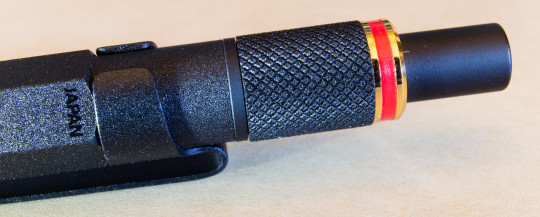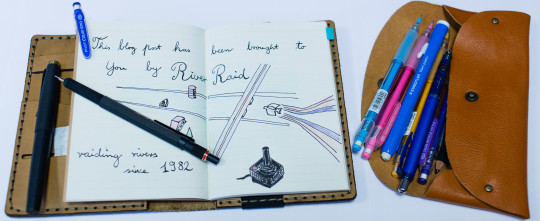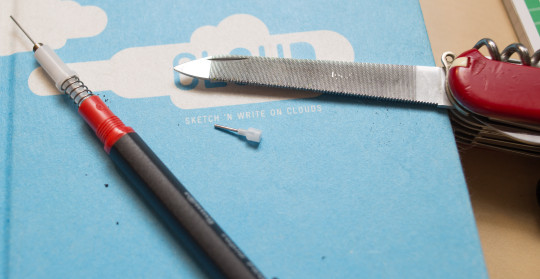Disappointed with the Rotring 800+’s stylus tip
I recently got the Rotring 800+ in black and 0.5mm, a mechanical pencil I was very excited about. Unfortunately, the 0.5 mm version in black was slightly more expensive than the silver or 0.7mm version.
What is special about the 800+
According to Rotring’s website, the Rotring 800 was introduced in 1993. It features a retractable sleeve and lead [1]It is not a sliding sleeve, so it is either fully retracted or fully extended. When retracted the sleeve will disappear in the body of the pen.. The Rotring 800+, introduced in 2014, is a very similar pencil that features a stylus tip at the front of the pencil, so when the sleeve is retracted you can use the front of the pencil for writing. In that respect, the 800+ is different as most ‘combination pens’ with a stylus tip have it at the end, for example instead of an eraser.

Rotring’s roller-coaster price
When including postage cost Amazon was the cheapest, selling this version for just under £49 (~$65; €59). Reichelt was cheaper, but unless you buy other products from them to get free shipping the postage cost would have ended making this order more expensive than on Amazon.
Well, suddenly, a few days later, this pen got £10 cheaper, despite the falling post-Brexit vote Pound and it now sells for under £39 (~ $52; €47). It was a gift from my wife, so I didn’t pay for it, but still, £10 cheaper now – not happy. Nevertheless, when it was bought £49 incl. postage was the cheapest price, as far as I know.
Do you remember my Scraping pencils post where I programmed an R script to track price developments on the Cultpens web site? Camelcamel does something similar, but automated, for Amazon products – and when you look the 800+ price is just crazy – according to Camelcamel this pen sold for nearly £60 in December 2014 but was less than £25 in December 2015.

Stylus performance
Have a look at this video where I have a look at the performance (if that is the right word here) of the stylus. It is quite disappointing. The Staedtler’s Noris Stylus is much cheaper, but performance is similar.
The video should display the force needed in Newton, but this doesn’t seem to display on all mobile devices. It should however work if you watch the video on a computer.
When I asked Rotring about the poor performance of the stylus tip their reply included these statements.
There is no difference of sensitivity between
different rubber. We also found that you do have to press a little more than with a finger.
Well, as you can see in my (unscientific) test there was a difference between different rubber tips. The second rubber tip that came with the pen needed a force of between 1.2 N and 1.5 N, but the third rubber tip only needed between 0.1 N and 0.8 N.
You need to press quite a bit for the stylus to work. Just a quick back of the envelope calculation that will not be very precise: if I take the Axial Pen Force mentioned in this paper [2]Van Den Heuvela, van Galenb, Teulingsc, van Gemmertc: Axial pen force increases with processing demands in handwriting, see http://www.sciencedirect.com/science/article/pii/S0001691898000316 and put them into the equation from this paper [3]
Schomaker, Plamondon: The relation between pen force and pen-point kinematics in handwriting, see http://link.springer.com/article/10.1007%2FBF00203451, assuming an angle of 45°, you get a normal pen force of less than 0.9 N. So I some users, on some devices, only have to press a little more than compared to normal writing, but I doubt these people use the same force when they use their fingers on their smartphone. In my case, because I don’t press very hard when writing, the normal pen force used is much lower than the 0.9 N from the back of the envelope calculation. I need to press harder than to get the 800+ to work on my devices, compared to writing on paper and I =most definitely= need to press harder to get the 800+ stylus tip to work compared to using my fingers.
I noticed that the force needed is different for different devices, so the Rotring 800+ might work better on your device, but in any case, you will need much more force than you would if you used your fingers.
I disagree with Rotring’s statements. As far as I can tell there seems to be a difference between different rubber tips and you need to press much more, not just ‘a little more than with your finger’ to get the stylus tip to work.
Conclusion
The Rotring 800+ brought a few disappointments:
- Having paid too much because the price is fluctuating so much (yes, you could blame Amazon for this, but of course people don’t want to pay more than necessary and the cheapest seller, Amazon, happens to be the one with the fluctuating price), making you think you might have gotten a bad deal.
- Performance of the stylus that is not at all as expected. Luckily I can use it ok-ish for swiping on my virtual keyboard [4]I use one of those swipe keyboard inputs as once you ‘get a lock’, i.e. the device recognised something is pressing against the display you don’t need too much force to keep the movement going.
Price and exchange rates: June 2016 (These are post-Brexit vote exchange rates)
If you found the bit about the axial pen force interesting, I have previously mentioned this, including in the Del Guard post.
You can find reviews of the 800+ at the Pen Addict and at Clicky Post. There is also a YouTube review of this pencil.
As usual, please open the images in a new tab to see them in high resolution.
References
| ↑1 | It is not a sliding sleeve, so it is either fully retracted or fully extended. When retracted the sleeve will disappear in the body of the pen. |
|---|---|
| ↑2 | Van Den Heuvela, van Galenb, Teulingsc, van Gemmertc: Axial pen force increases with processing demands in handwriting, see http://www.sciencedirect.com/science/article/pii/S0001691898000316 |
| ↑3 | Schomaker, Plamondon: The relation between pen force and pen-point kinematics in handwriting, see http://link.springer.com/article/10.1007%2FBF00203451 |
| ↑4 | I use one of those swipe keyboard inputs |
Disappointed with the Rotring 800+’s stylus tip Read More »









![That's one small scrape off [a] sleeve, one giant leap in the friction chart.](https://bleistift.blog/wp-content/uploads/2015/10/pimpmyrotring5-540x405.jpg)









